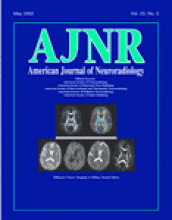Findings from the most recent studies suggest that the incidence of leptomeningeal tumor continues to increase. Multiple reasons are generally cited. First, methods of diagnosis have improved with respect to the evaluation of cytologic features. Second, as patients continue to live longer with their systemic tumors due to refinements in treatment, ancillary complications of the disease, such as leptomeningeal tumor, have more time to develop. Third, improvements in imaging increase the number of leptomeningeal tumor diagnoses.
The major advance in the imaging evaluation of leptomeningeal tumor occurred with the introduction of contrast agents and their use with routine T1-weighted spin-echo sequences. Previous evaluations with contrast-enhanced CT had been suboptimal. The advent of contrast-enhanced MR imaging, however, has substantially increased the diagnostic rate of leptomeningeal tumor. Studies in which the original techniques are used demonstrate positive imaging findings in approximately one to two thirds of patients with documented leptomeningeal tumor.
While the rate of diagnosis by means of imaging has increased, the potential for diagnosis with the evaluation of the CSF itself remains. The evaluation of the CSF results in positive cytologic findings in approximately 45% of cases after one lumbar puncture, approximately 85% of cases after two lumbar punctures, and approximately 95% of cases after six lumbar punctures. These results are dependent on highly skilled cytologists and the withdrawal of relatively large volumes, approximately 15–20 mL, of CSF at each lumbar puncture. Realistically, in today’s clinical setting, very few patients undergo such extensive, invasive, and uncomfortable examinations for the diagnosis of leptomeningeal tumor. Therefore, imaging has become even more important than it was previously.
Although the simple T1-weighted contrast-enhanced spin-echo sequence was the first method in the evaluation of leptomeningeal tumor, other sequences have also been considered. Surprisingly, magnetization-transfer techniques, which proved to be effective in increasing the conspicuity of contrast enhancement in parenchymal lesions, have been somewhat less optimal in the evaluation of suspected leptomeningeal tumor; this limitation is possibly due to the increased depiction of normal cortical veins along the surface of the brain, which make the diagnosis of leptomeningeal tumor more difficult.
Another technique that has been proposed for use with contrast enhancement is three-dimensional spoiled gradient-echo imaging, which allows easy multiplanar reformation. One specific disadvantage with respect to the evaluation of leptomeningeal tumor is that the incidence of normal meningeal enhancement with spoiled gradient-echo images tends to be higher than that of routine T1-weighted spin-echo imaging. Because normal meninges do enhance with spoiled gradient-echo sequences and because this enhancement tends to be more visible than it is with routine T1-weighted spin-echo sequences, spoiled gradient-echo sequences have significantly less specificity in the diagnosis of leptomeningeal tumor, particularly in subtle cases.
Fluid-attenuated inversion recovery (FLAIR) imaging is the first new technique to realistically challenge the role of contrast-enhanced T1-weighted spin-echo sequences in the diagnosis of leptomeningeal tumor. Its success has been controversial. Some have noted improved diagnostic rates, while others have cited problems from lack of appropriate fluid signal suppression, particularly with CSF pulsation in the important region of the basal cisterns. Because leptomeningeal tumor is often diagnosed by noting the enhancement of the cranial nerves in the region of the basal cisterns, the lack of reliable CSF signal suppression in these areas of increased pulsatility has proved highly problematic.
The goal of increasing the imaging sensitivity to leptomeningeal tumor remains. The proposal of the current article by Singh et al in this issue of the AJNR is intriguing. Their hypothesis is that, by combining the best of T1-weighted contrast-enhanced sequences with FLAIR sequences, the diagnostic capabilities of MR imaging can be increased even further. In this study, they compared the roles of contrast-enhanced T1-weighted spin-echo imaging with nonenhanced and contrast-enhanced FLAIR imaging. The results, however, are not as they originally hypothesized. Rather, contrast-enhanced T1-weighted spin-echo sequences remain the sequences of choice in the evaluation of suspected leptomeningeal tumor. The combination of nonenhanced FLAIR and contrast-enhanced T1-weighted imaging has proved to be optimal. Happily, nonenhanced FLAIR and contrast-enhanced T1-weighted sequences are already incorporated into most protocols used for the evaluation of suspected leptomeningeal tumor. The sensitivity of MR imaging in the evaluation of leptomeningeal tumor, by using all of the sequences, was 60%; this percentage is near the upper limits of numbers cited in earlier reports.
Given the importance of leptomeningeal tumors and the invasiveness of making the diagnosis by actually examining the CSF, it is unfortunate that our effectiveness in diagnosing this important clinical entity by means of imaging has not increased even further. Nevertheless, the article by Singh et al reinforces the continued importance of imaging and the relative reliability of these techniques.
One final note is interesting. Our first efforts with contrast enhancement in the evaluation of suspected leptomeningeal tumor involved standard T1-weighted spin-echo sequences. After all these years, “plain vanilla” T1-weighted spin-echo sequences still remain the techniques of choice for use with contrast material.
- Copyright © American Society of Neuroradiology












